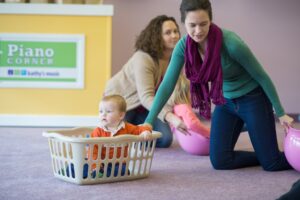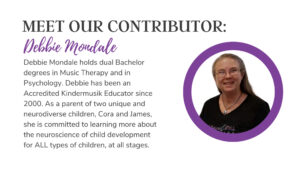Tag: gross motor skills
The Bountiful Benefits of Basket Rides
Wheeee! Bet your toddler loves going for rides in your laundry basket. What you may not know are all the developmental benefits you are giving your child in these moments, and some of the ways you can make this an even more beneficial experience for you and your little one.
View this post on Instagram
First, notice how these parents work smarter, not harder, by having a scarf or rope attached to the basket enabling them to stand up and protect their back muscles. (These are the kind of parenting tips our experienced Kindermusik educators share to set you up for success.)
Second, each parent is respecting their baby’s needs during this activity. Some little ones are enchanted by being pulled in the basket, others want to be close and cuddle as they are parading around the room. Toddlers who are totally focused on walking may want to put their favorite stuffed animal in the basket and push it around themselves!
So let’s highlight some of the benefits of this traveling laundry basket experience.
Balance and Coordination
Sitting upright in a laundry basket as it is moving forward and side to side activates and strengthens your child’s core muscles, and is a delightful exercise for developing balance and coordination. So if they are old enough to sit up by themselves, place them in the center so they are less inclined to lean back. Don’t worry too much if they do.
Spatial Awareness
As your child sees and feels themselves traveling through the room, they are becoming more aware of where they are in relation to the space around them. Your child is developing the spatial awareness they need to navigate the world around them.
Sensory Stimulation
Whether your child is sitting directly on the grooves in the bottom of the laundry basket, or a soft towel or blanket on the bottom, they are getting sensory input from the density and textures on their skin as their body moves around on top. Try it with a load of warm laundry for additional sensory input. Both the warmth of the clothes and the scent of the fabric softener strengthens the building of strong neural connections.
As your toddler’s eyes see objects move past them, they are becoming more observant of their environment and how things look from different perspectives. To activate the same effect with their hearing, have music playing in one room, and move past the door to that room so your child’s ears hear the changing location of the sound.
Imaginative Play
Does your child love trains? Create chugging sounds and train whistles, and maybe even listen to songs about trains on your laundry basket adventure. Pretend to make scheduled stops and announce the location loudly. There are so many ways to stimulate their ability for imaginative play on a topic they love. If your child loves their stuffed animals, set them up around the house and pretend to be a train traveling around the zoo and talking about each animal. Maybe they can be the zoo expert after your many repetitions. Start by becoming acutely aware of what your child is most fascinated by in this moment, and initiate pretend play accordingly. Then watch as your child starts to initiate it in their own.
ADD Social Interaction
 Some of these suggestions are extras you can add that we can’t include in our Kindermusik classes. But your mommy and me time (or daddy and me, grandma and me, nanny and me…) during class provides you with a continual supply activities, music, and information to level up your daily play at home. You will both meet new friends with your classmates, adding the benefit of socialization and interpersonal connection.
Some of these suggestions are extras you can add that we can’t include in our Kindermusik classes. But your mommy and me time (or daddy and me, grandma and me, nanny and me…) during class provides you with a continual supply activities, music, and information to level up your daily play at home. You will both meet new friends with your classmates, adding the benefit of socialization and interpersonal connection.
It is so easy to sign up and preview one of our classes full of music and movement with your child. Our unique programs for each age (infancy, early toddlerhood and early preschool ages) ensures you are both gaining what you need for each stage of their development.
Let’s nurture these young minds together. Wheee!

For the Love of Bunnies and Benefits
Does your toddler have a snuggly bunny they LOVE? Then they will LOVE playing this game with their furry friend. For such a little children’s rhyme, there is a lot of learning happening with your expressive interactions and repeated play.
View this post on Instagram
Expand on their Interest
When your child has a strong interest in something, it offers an exceptional opportunity to expand so many areas of their childhood development. Positive emotions attached to learning opportunities result is a longer attention span, interest in repetition, and stronger neural connections for more well-rounded learning. With new and unique ways
to play with their favorite objects, their interest in it will last longer and they become curious to learn more. “What else can I do with this?” This question itself has lifelong benefits for their curiosity and knowledge building.
Language Development
Simply hearing the cadence of rhyme is immersing your child in learning the format and concepts of speech, even in the earliest stages of your baby’s language development. Toddler’s brains are avidly seeking the connection between words and actions, helping with both their receptive language (understanding what others say), and their expressive language (ability to communicate using their own words).
Focused Attention / Observation
When the rhyme says “I see..”, we are reinforcing our child’s observational skills, increase their attention span as they keep looking at an object to find and describe the many things they see with their eyes.
Sign Language
 Even when your child can hear perfectly well, using sign language in coordination with speech has cognitive benefits. When a child can SEE and HEAR the word at the same, they are learning two ways to express the same concept, which builds stronger neural connections leading to easier language development AND, there are times you and
Even when your child can hear perfectly well, using sign language in coordination with speech has cognitive benefits. When a child can SEE and HEAR the word at the same, they are learning two ways to express the same concept, which builds stronger neural connections leading to easier language development AND, there are times you and
your child may want to communicate silently. Using the sign for SEE can be used when you discover a real animal outside and don’t want to scare them, when you are in a quiet place and need to communicate, and so many more life circumstances. Along with the silent mouthing of “Yay” at the end, the wiggling hands in the air is sign language for celebrating. It is also how people who are deaf applaud each other for accomplishments. Having a quiet visual way to celebrate appreciation of your child’s actions can also come in very handy.
Emotional Awareness
“Surprise!” is such a fun facial expression to imitate. AND… It is a fabulous word to use when your child is startled instead of the word “scared”. “Oh, I didn’t mean to surprise you.” may help your child have a more positive reaction, and recover more quickly. As we play around with the facial expressions for sad and happy at the end, two year
olds and preschoolers are learning to read facial expressions and recognize the emotions they are associate with… an amazing start in developing their emotional intelligence.
Turn-Taking prepares for school readiness
At first, you will be chanting the rhyme and moving the bunny. Your child “turn” will likely be to request it again and again. Once the rhyme is familiar, your child may move the bunny while you chant the rhyme. Little step toward letting them take on more of the experience can be leaving off some of the repeated words at the end, and let them say the repeated quiet words. As you continue to leave off more of the ending words their memory for the rhyme is building until they can complete it all themselves. Maybe while you are moving the bunny???
Memorization leads to better reading skills
“Experts in literacy and child development have discovered that if children know eight nursery rhymes by heart by the time they’re four years old, they’re usually among the best readers by the time they’re eight. “- Mem Fox, Reading Magic
Motor Skill Development and Inhibitory Control
As your child moves the bunny along with the rhyme, they are by creating the correct movements in connection with the action words they hear. They are practicing, in a delightful way, when to move and stop, and moving faster and slower. As we highlight how proud they are of this control over their gross motor skills, it will build their desire to
have this control in other situations.
By using two FINGERS outward from a fist, your “hand” bunny can move along with this rhyme and help develop their fine motor skills as well. This can be a great game to play while waiting in line at the grocery store, or in a doctors office. No props needed.
Musical awareness
Last, but not least, this rhyme introduces opposing concepts in a perfect way to develop early childhood development in cognition and music, at first in awareness and progressing toward active skills:
Loud and quiet are introduced by the repeated sounds, with the first three louder and followed by more with a quiet voice.
Crescendo (getting louder) and Decrescendo (getting louder) as well as melodic direction (the pitcho going up and down are introduced with the “bloops” as the bunny hops away (starting loud with a higher pitch) and hops back (starting with a quiet and lower pitch).
Ready for more?
 Now that your child is ready to expand connections to their favorite bunny friend, you can continue to add more. Download the free Kindermusik APP on any mobile device, and enjoy these songs. Once in, click on the MUSIC tab at the bottom, tap on SONGS at the top, and search for RABBIT. “I Saw a Little Rabbit” and “Usagi, Usagi”
Now that your child is ready to expand connections to their favorite bunny friend, you can continue to add more. Download the free Kindermusik APP on any mobile device, and enjoy these songs. Once in, click on the MUSIC tab at the bottom, tap on SONGS at the top, and search for RABBIT. “I Saw a Little Rabbit” and “Usagi, Usagi”
When you and your child participate in our Kindermusik classes with our accredited educators at Grow and Sing Studios, we’d love to hear what your child’s interests are so we can provides songs and activities to expand the things that bring them joy. We have so many resources to make it a little easier for you to connect with your child and
provide life-long benefits in their development. A big bonus when you enroll is accessing a much larger selection of music, books, and more on the Kindermusik App.
Sign up to Preview a Class with us today and see the magic in action.
If you have some favorite rhymes, songs or stories about bunny rabbits you would
recommend to other parents, please share in the comments!
